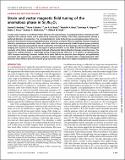Files in this item
Strain and vector magnetic field tuning of the anomalous phase in Sr3Ru2O7
Item metadata
| dc.contributor.author | Brodsky, Daniel O. | |
| dc.contributor.author | Barber, Mark E. | |
| dc.contributor.author | Bruin, Jan A. N. | |
| dc.contributor.author | Borzi, Rodolfo A. | |
| dc.contributor.author | Grigera, Santiago A. | |
| dc.contributor.author | Perry, Robin S. | |
| dc.contributor.author | Mackenzie, Andrew P. | |
| dc.contributor.author | Hicks, Clifford W. | |
| dc.date.accessioned | 2017-03-16T10:30:16Z | |
| dc.date.available | 2017-03-16T10:30:16Z | |
| dc.date.issued | 2017-02-03 | |
| dc.identifier | 249386938 | |
| dc.identifier | 8ea9c3df-7df7-417c-99bb-fc9619c2e6a5 | |
| dc.identifier | 85041731151 | |
| dc.identifier | 000397039500001 | |
| dc.identifier.citation | Brodsky , D O , Barber , M E , Bruin , J A N , Borzi , R A , Grigera , S A , Perry , R S , Mackenzie , A P & Hicks , C W 2017 , ' Strain and vector magnetic field tuning of the anomalous phase in Sr 3 Ru 2 O 7 ' , Science Advances , vol. 3 , no. 2 , e1501804 . https://doi.org/10.1126/sciadv.1501804 | en |
| dc.identifier.issn | 2375-2548 | |
| dc.identifier.other | crossref: 10.1126/sciadv.1501804 | |
| dc.identifier.uri | https://hdl.handle.net/10023/10480 | |
| dc.description | This work was supported by the Max Planck Society, the U.K. Engineering and Physical Sciences Research Council (grants EP/1031014/1 and EP/G03673X/1), Agencia Nacional de Promoción Científica y Tecnológica (Argentina) through Proyecto de Investigación Científica y Tecnológica 2013 N•2004 and N•2618, and Consejo Nacional de Investigaciones Científicas y Técnicas. Data underpinning this publication can be accessed at http://edmond.mpdl.mpg.de/imeji/collection/FTJwbUj1iAnXbffX. Additional data related to this paper may be requested from the authors. | en |
| dc.description.abstract | A major area of interest in condensed matter physics is the way electrons in correlated electron materials can self-organize into ordered states, and a particularly intriguing possibility is that they spontaneously choose a preferred direction of conduction. The correlated electron metal Sr3Ru2O7 has an anomalous phase at low temperatures that features strong susceptibility toward anisotropic transport. This susceptibility has been thought to indicate a spontaneous anisotropy, that is, electronic order that spontaneously breaks the point-group symmetry of the lattice, allowing weak external stimuli to select the orientation of the anisotropy. We investigate further by studying the response of Sr3Ru2O7 in the region of phase formation to two fields that lift the native tetragonal symmetry of the lattice: in-plane magnetic field and orthorhombic lattice distortion through uniaxial pressure. The response to uniaxial pressure is surprisingly strong: Compressing the lattice by ~0.1% induces an approximately 100% transport anisotropy. However, neither the in-plane field nor the pressure phase diagrams are qualitatively consistent with spontaneous symmetry reduction. Instead, both are consistent with a multicomponent order parameter that is likely to preserve the point-group symmetry of the lattice, but is highly susceptible to perturbation. | |
| dc.format.extent | 9 | |
| dc.format.extent | 2188572 | |
| dc.language.iso | eng | |
| dc.relation.ispartof | Science Advances | en |
| dc.subject | Sr3Ru2O7 | en |
| dc.subject | Ruthenates | en |
| dc.subject | Uniaxial pressure | en |
| dc.subject | Vector magnetic field | en |
| dc.subject | Quantum criticality | en |
| dc.subject | Density wave | en |
| dc.subject | Two-component order parameter | en |
| dc.subject | Strain tuning | en |
| dc.subject | QC Physics | en |
| dc.subject | DAS | en |
| dc.subject | BDC | en |
| dc.subject.lcc | QC | en |
| dc.title | Strain and vector magnetic field tuning of the anomalous phase in Sr3Ru2O7 | en |
| dc.type | Journal article | en |
| dc.contributor.sponsor | EPSRC | en |
| dc.contributor.institution | University of St Andrews. School of Physics and Astronomy | en |
| dc.contributor.institution | University of St Andrews. Condensed Matter Physics | en |
| dc.identifier.doi | https://doi.org/10.1126/sciadv.1501804 | |
| dc.description.status | Peer reviewed | en |
| dc.identifier.grantnumber | EP/I031014/1 | en |
This item appears in the following Collection(s)
Items in the St Andrews Research Repository are protected by copyright, with all rights reserved, unless otherwise indicated.

